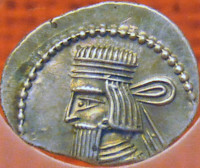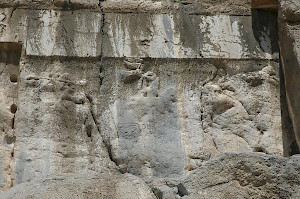Gotarzes II
Gotarzes II: Arsacid king of the Parthian Empire (r.29?-51).

In 38 CE, the Parthian king Artabanus II died; his main achievement may have been that he had kept the kingdom together, although he first had to win a civil war against his brother Vonones I and had later won a civil war against another relative, Tiridates II. His son Vardanes I, who appears to have been co-ruler since 29 CE, succeeded him.note
Immediately, Vardanes' brother Gotarzes II, another son of Artabanus II, claimed the throne as well. He may have found support in the Parthian capital, Seleucia on the Tigris, which would be revolting for seven years.note The Roman historian Tacitus, who is confused about the date, tells that Gotarzes, with the support of the Hyrcanians and Dahae nomads, expelled his brother, who fled to Bactria, where he enlisted nomadic tribal warriors (perhaps the Yuezhi).note Before it came to battle, Gotarzes allowed himself to be convinced that it was better to abandon his claims.note
In c.47, Vardanes was assassinated. Tacitus writes:
By the murder of Vardanes Parthian affairs were thrown into confusion, as there was no unanimity with regard to his successor. Many leaned to Gotarzes; some to Phraates' descendant Meherdates, who had been given in hostage to the Romans. Then Gotarzes carried the day, made himself master of the palace, and by dint of cruelty and debauchery drove the Parthians to send a secret petition to the Roman emperor, pleading that Meherdates might be set free to ascend the throne of his fathers.note

The emperor Claudius (r.41-53) recognized the opportunity - did he know that in Margiana, another rebel named Sanabares was active? - and in 49, Meherdates crossed the Euphrates at Zeugma, met king Abgar V of Osrhoene, proceeded to Edessa, crossed the Tigris, reached Nineveh, met the army of Gotarzes, and was defeated. (A very damaged relief in Behistun commemorates this event.) Tacitus:
Meherdates was thrown into chains and surrendered to the victor, who, upbraiding him as no relative of his, nor a member of the Arsacid house, but an alien and a Roman, struck off his ears and commanded him to live - an advertisement of his own mercy and of our dishonor.note

Tacitus continues with a remark that Gotarzes fell ill and died;note Josephus writes that he was assassinated.note In any case, the new ruler was a man named Vonones II, who was almost immediately succeeded by his son Vologases I.
Perhaps Rock Relief V in Sar-e Pol-e Zahab, along the road from Babylonia to Media, was made for Gotarzes II, although Gotarzes I is another possibility. On balance, however, Gotarzes II seems to be the better candidate.
Note
The chronology of the Arsacid kings of the Parthian Empire is less well-understood than, for example, the sequence of Seleucid and Ptolemaic kings or the emperors of Rome. This information is based on the researches by G.R.F. Assar, as published in "Iran under the Arsakids, 247 BC – AD 224/227" in: Numismatic Art of Persia (2011).